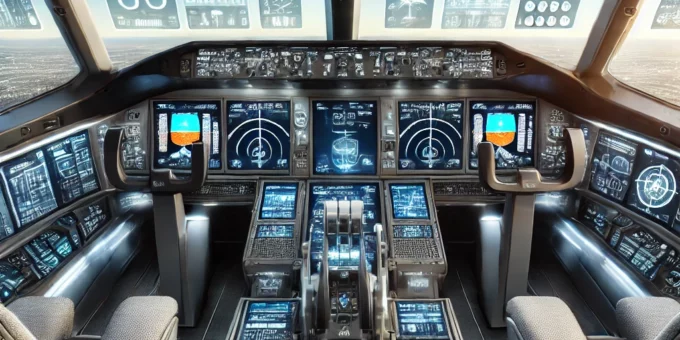
Modern aviation is experiencing a transformative wave as pilot technology takes center stage in enhancing flight efficiency. From real-time data integration to automation, advancements in aviation technology are reshaping how we approach air travel. By prioritizing innovations, the industry not only boosts performance but also addresses environmental concerns and passenger satisfaction.
The Evolution of Pilot Technology
Over the decades, aviation has transitioned from rudimentary analog systems to highly sophisticated digital technologies. Early aircraft relied heavily on manual controls and mechanical instruments, requiring immense skill and concentration from pilots. Today, we see cockpits brimming with digital interfaces, touchscreen displays, and interconnected systems that provide pilots with unparalleled control and awareness.
This evolution has been a journey of reducing errors, streamlining operations, and increasing safety. Digital flight management systems now handle everything from navigation to fuel consumption, ensuring every aspect of the flight is optimized.
Understanding Flight Efficiency
Flight efficiency is a critical metric for airlines and passengers alike. It encompasses various factors, including fuel usage, route optimization, air traffic coordination, and time management. Efficient flights not only save resources but also minimize delays and emissions, making aviation more sustainable.
Pilot technology plays a pivotal role in achieving these objectives. By harnessing advanced tools and real-time insights, pilots can make decisions that directly enhance operational efficiency.
Automation in Cockpits
Automation has revolutionized how pilots operate aircraft. Autopilot systems, for instance, can manage most of the flight with minimal human input, allowing pilots to focus on critical decisions. These systems utilize data from multiple sources, such as onboard sensors, weather updates, and satellite navigation, to adjust speed, altitude, and direction seamlessly.
Furthermore, automation reduces pilot fatigue, as routine tasks are handled by the system, allowing for better focus during takeoff, landing, or emergencies.
Real-Time Data Integration
Modern cockpits are equipped with sensors and connectivity tools that deliver real-time data to pilots. This data includes weather conditions, traffic updates, and performance metrics, enabling more informed decision-making.
For example, real-time turbulence detection systems warn pilots of potential disruptions, allowing them to adjust their flight path and maintain passenger comfort. Additionally, live connectivity with air traffic control ensures that flights remain coordinated, even in congested airspace.
Fuel Management Technologies
Fuel is one of the most significant costs for airlines, making efficient fuel management a top priority. Advanced pilot technology assists in optimizing fuel usage through better route planning, speed adjustments, and altitude selection.
For instance, flight management systems analyze various factors, such as wind patterns and air traffic, to recommend the most fuel-efficient paths. The result? Lower costs for airlines and a reduced environmental footprint.
AI in Aviation
Artificial intelligence has become a game-changer in aviation. By processing vast amounts of data, AI systems provide pilots with predictive insights and recommendations. These tools analyze everything from engine performance to weather forecasts, ensuring pilots are always a step ahead.
AI-powered systems also enable predictive maintenance, identifying potential mechanical issues before they become serious problems. This not only enhances safety but also reduces costly delays.
Weather Tracking Systems
Weather conditions are one of the most unpredictable factors in aviation. Modern tracking systems equipped with advanced radar and satellite technology give pilots a comprehensive view of weather patterns.
These systems can identify storms, turbulence, and other adverse conditions, allowing pilots to plan safer and more efficient routes. Improved weather tracking also minimizes delays, ensuring flights stay on schedule.
Environmental Impact of Efficiency
Flight efficiency is directly linked to sustainability. By reducing fuel consumption, airlines significantly lower their carbon emissions. Technological innovations in pilot systems are enabling this shift toward greener aviation.
Electric and hybrid aircraft are on the horizon, promising a future where efficiency and environmental responsibility go hand in hand. Current technologies, like precision navigation, further contribute by reducing unnecessary flight time and fuel usage.
Challenges in Implementing Technology
Despite its advantages, adopting advanced pilot technology is not without challenges. High costs, lengthy training programs, and the need for infrastructure upgrades can slow down implementation. Moreover, ensuring that new systems integrate seamlessly with existing frameworks requires meticulous planning and collaboration.
However, as the benefits outweigh the drawbacks, the industry is steadily overcoming these hurdles through partnerships and innovation.
FAQs
What is pilot technology in aviation?
Pilot technology refers to the tools and systems that assist pilots in managing and optimizing flights. These include autopilot systems, navigation tools, and real-time data integration.
How does technology improve flight efficiency?
It enhances decision-making, optimizes fuel usage, reduces delays, and improves overall operational performance.
Are automation systems safe for aviation?
Yes, modern automation systems are designed with multiple redundancies and safety protocols, making them highly reliable.
What role does AI play in aviation?
AI aids in predictive maintenance, real-time decision-making, and analyzing large datasets to enhance flight efficiency.
What are the environmental benefits of efficient flights?
Efficient flights reduce fuel consumption and carbon emissions, contributing to a greener aviation industry.
What challenges exist in adopting pilot technology?
High costs, extensive training, and integration complexities are the primary challenges in adopting advanced pilot technology.
You Can Also Read : How to Implement Effective Link-Building Strategies for SEO
Conclusion
Pilot technology is reshaping the future of aviation by prioritizing efficiency, safety, and sustainability. As innovations continue to emerge, the industry is set to achieve unprecedented levels of performance and reliability. Airlines, passengers, and the environment all stand to benefit from these advancements, making aviation a key driver of progress in modern transportation.